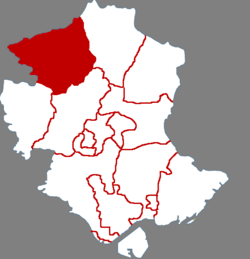Zunhua
Zunhua
遵化市 Tsunhwa | |
|---|---|
 The tomb of Empress Dowager Cixi in Zunhua | |
 | |
| Coordinates (Zunhua municipal government): 40°11′20″N 117°57′58″E / 40.189°N 117.966°E | |
| Country | People's Republic of China |
| Province | Hebei |
| Prefecture-level city | Tangshan |
| Area | |
| • County-level city | 1,521.0 km2 (587.3 sq mi) |
| • Urban | 85.80 km2 (33.13 sq mi) |
| Population (2017) | |
| • County-level city | 794,000 |
| • Urban | 243,200 |
| Time zone | UTC+8 (China Standard) |
Zunhua (Chinese: 遵化; pinyin: Zūnhuà) is a county-level city in the northeast of Hebei province, China, bordering Tianjin to the west. It is under the administration of the prefecture-level city of Tangshan. Historic sites include the Eastern Qing Tombs (Qing Dongling).
Administrative divisions
Zunhua has jurisdiction over 2 subdistricts, 13 towns, and 12 townships.[2]
Subdistricts
Zunhua contains the subdistricts of Huaming Road Subdistrict (华明路街道) and Wenhua Road Subdistrict (文化路街道).[2]
Towns
Zunhua contains the following 13 towns:[2]
- Zunhua (遵化镇)
- Baozidian (堡子店镇)
- Malanyu (马兰峪镇)
- Ping'ancheng (平安城镇)
- Dongxinzhuang (东新庄镇)
- Xindianzi (新店子镇)
- Dangyu (党峪镇)
- Dibeitou (地北头镇)
- Dongjiuzhai (东旧寨镇)
- Tiechang (铁厂镇)
- Sujiawa (苏家洼镇)
- Jianming (建明镇)
- Shimen (石门镇)
Townships
Zunhua contains the following 12 townships, of which, 3 are Manchu ethnic townships:[2][3]
- Xiliucun Township (西留村乡)
- Cuijiazhuang Township (崔家庄乡)
- Xingwangzhai Township (兴旺寨乡)
- Liubeizhai Township (刘备寨乡)
- Tuanpiaozhuang Township (团瓢庄乡)
- Niangniangzhuang Township (娘娘庄乡)
- Xisanli Township (西三里乡)
- Houjiazhai Township (候家寨乡)
- Xiaochang Township (小厂乡)
- Xixiaying Manchu Ethnic Township (西下营满族乡)
- Tangquan Manchu Ethnic Township (汤泉满族乡)
- Dongling Manchu Ethnic Township (东陵满族乡)
Geography
Most of the city's terrain consists of small mountains, hills, and valleys, and a number of rivers, such as the Sha, Li, Lin, and Weijin flow through the city.[2] Significant mountains in Zunhua include Jiufeng Mountain, Taohua Mountain, Wolong Mountain, and Huanghua Mountain.[2]
Demographics
As of 2017, Zunhua had a population of 794,000, of which, 243,200 resided in urban areas.[4] 114,500 people in Zunhua are ethnic minorities, the largest number in Tangshan.[3]
Economy
Zunhua is home to mineral deposits containing minerals such as iron, manganese, chromium, copper, lead, zinc, gold, and dolomite.[2]
Energy
141,100 people in Zunhua have access to natural gas, of which, 90,200 have access to LPG.[4]
Transportation
A number of railways and highways pass through the city.[2]
Road
The following highways pass through Zunhua:[2]
Rail
The following railroads pass through Zunhua:[2]
See also
References
- ^ a b Ministry of Housing and Urban-Rural Development, ed. (2019). China Urban Construction Statistical Yearbook 2017. Beijing: China Statistics Press. p. 46. Retrieved 11 January 2020.
- ^ a b c d e f g h i j 遵化市概况地图_行政区划网(区划地名网) www.xzqh.org. xzqh.org. Retrieved 2020-04-24.
- ^ a b 人口民族 [Population and Ethnicity]. Tangshan Municipal People's Government. 2019-07-15. Archived from the original on 2019-07-28. Retrieved 2021-01-17.
- ^ a b "China Urban Construction Statistical Yearbook 2017". Ministry of Housing and Urban-Rural Development. 2019. Retrieved April 24, 2020.
- http://www.china.org.cn/english/kuaixun/75232.htm
- https://web.archive.org/web/20070819215604/http://www.zunhua.gov.cn:80/enews.cfm?lanmu=liuyou&type=A%20Survey%20of%20Tour%20Business&id=21
- Seventeen die from China gas leak (BBC) - Gas leak at steel plant in Zunhua, December 2008
External links

